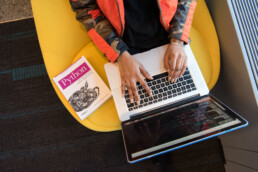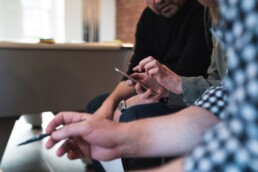Keeping Agile In The Evolving Creative Marketplace
Good news, if you are reading this post – you’re already one step ahead. In the current and constantly changing design and technology landscape, talent and drive are key – but being informed will push the envelope further. Staying on top of industry trend patterns, innovators, designers and developments allows an already creative mind the space to open up even more possibilities for the future.
Read (or Listen) Up
From blogs to print magazines and journals – gathering knowledge by keeping tabs on the latest publications is one of the best ways to stay in the know. Digital content is highly up-to-date but can sometimes be fleeting since trends change regularly. Keep an eye out for content patterns – if you begin to see multiple publications on the same topic, it’s probably worth a second look. If you can’t spare the time, podcasts are also an ideal way to get informed on new ideas from thought leaders in the marketplace.
Engage
Identify and follow like-minded people, organizations and companies on social media. If they haven’t made it private, you can see who they have connected with to grow your network and information channels. By following and connecting with people with parallel interests, you can see what techniques or projects they are working on that might pique your creativity.
Network & Participate
We’re guilty of spending too much time behind the screen. Getting out and attending meet-ups, seminars and even joining a co-working space can open doors you didn’t even know were there. The digital and creative industries have some of the most prolific organizations and groups, such as AIGA and Creative Mornings with chapters in almost every region, as well as smaller, more specific groups targeting specialized fields like Women Who Code and The Interaction Design Foundation.
Collaborate
Share creative ideas and information with people you think might share your interests. Whether it’s posting an interesting article or reaching out to someone for an opinion, these actions lead to an informed connection. Initiate a project that you’ve been thinking about with a group that inspires you, and start a weekly creative meeting – you never know what free-flowing ideas can lead to the next big innovation or get your creative endorphins going.
Create
As designers and creatives – we are always making. However creative we might be in our daily lives for employers or clients – it’s important to set aside time for your creative pursuits. This can be as simple as posting photos to social media or a blog, painting, writing or even cooking. This creative outlet is for you and should be a place that calms, excites and drives you to keep developing creatively – personally and professionally.
Explore
Get out and play! You can only consume so much information at a time. Experiential inspiration can change the direction of the creative process and your outlook on life. With expectations of both work and personal, many have to force themselves to get out and explore – even feeling guilt as they do so. If this is the case, assign yourself a goal based on the experience – (i.e.) if visiting a gallery or new restaurant, post photos of your experience or write an editorial of your thoughts.
Creative flow doesn’t have to end when the workday is done, nor does it have to feel like work. Understanding that everyone always has more to learn will allow you to stay curious, keeping your eyes open to new experiences and knowledge.
Revolutionizing UX Design with the Binary Approach to Project Management
Embracing a clear approach to task completion—where tasks are strictly marked as 'done' or 'not done'—can significantly enhance the efficiency, clarity, and accountability of UX projects. This project management method offers a straightforward…
Human-Centered Design: The Heart of Creating Impactful Digital and Physical Experiences
Whether it be digital, physical, or conceptual, one philosophy consistently emerges as the cornerstone of impactful and effective creation: Human-Centered Design (HCD). At its core, Human-centered design isn’t just a methodology; it’s a…
The Conundrum of Empathy in UX Design: A Driving Force or an Unrealistic Ideal?
Empathy is often touted as the backbone of user experience (UX) design, a tool to perceive and feel what end users might experience. However, the practicality and efficacy of empathy in UX design is a subject of intense debate. While empathy can be…



